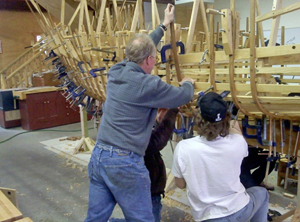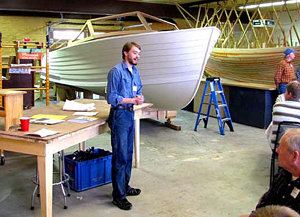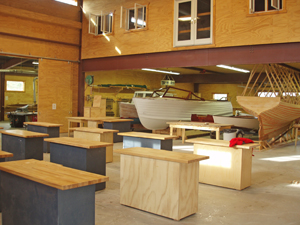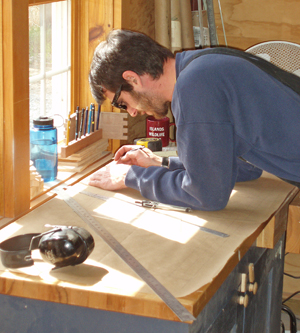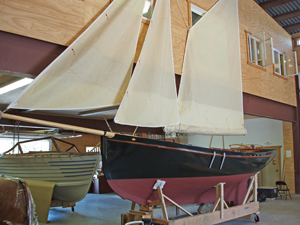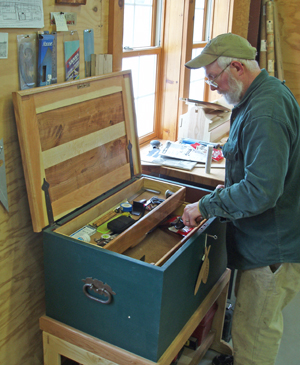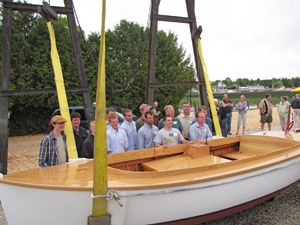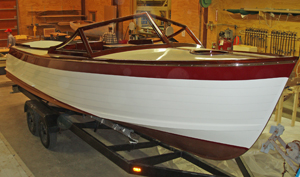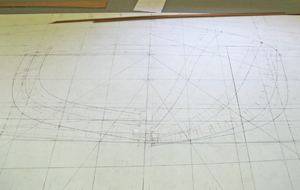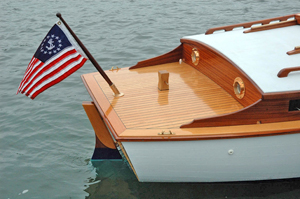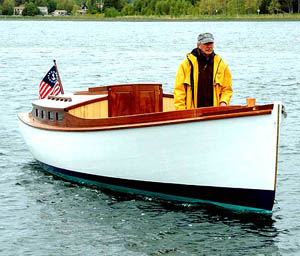
Ten years ago, Bud McIntire, a former architect of 35 years, probably never would have dreamed he’d one day be building wooden boats — or that he’d be helping students pursue boatbuilding as a vocation. But, a confluence of “odd circumstances” and a desire for a career change to work with his hands motivated McIntire to retire from an architectural firm. He enrolled as a student at the Great Lakes Boat Building School (GLBBS) last year and is completing the second of its two-year intensive curriculum this year. He serves as GLBBS’s student services coordinator at its facility in Cedarville, Michigan, while attending school.
One of just five major wooden boatbuilding schools in the nation, GLBBS was a logical choice for him to pursue his second career as a woodworker. “It’s purposefully designed for boatbuilding and is taught by two of the finest instructors out there — program director and career wooden boat builder Pat Mahon and instructor Adam Burks.” Bud explained that the not-for-profit school came about as the collaborative effort and vision of local citizens, many of whom are women. “There has always been enthusiasm for and an appreciation of classic wooden boat building in this area of Michigan’s Upper Peninsula, and the community was looking for an opportunity to boost the local economy. There was so much support from donors that it took just 18 months to go from initial discussions to a completed school facility that was ready for students.”
“Becoming a boatbuilder later in life really isn’t that unusual,” McIntire admits. “About a third of our graduates are folks in their 30s, 40s or older who were looking for a career change. Our oldest graduate was 78, and he intended to put those skills to work as a new career.” The other two-thirds of the school’s 52 graduates to date have been students in their 20s — some with college experience or just out of high school. Those who complete one or both academic years of GLBBS’s Comprehensive Boat Building Program face excellent job prospects. The school, which opened its 12,000 square-foot facility to students in 2007, boasts a 100 percent placement rate.
“The Great Lakes region and our U.S. coasts, particularly in the Seattle and New England areas, have a rich history of wooden boatbuilding, restoration and repair. But, master boatbuilders are getting older and are retiring. There aren’t many craftspeople in this trade filling in behind these guys. So, those who want to pursue a career in boatbuilding shops or to start their own shop can definitely get work doing it. It’s a vocation that has really held up well during this recession.”
McIntire says GLBBS focuses its curriculum on fundamentals. Some familiarity with woodworking is beneficial, but that isn’t a prerequisite for enrollment. First-year students start out making a step stool and then a tool chest to learn shop safety and basic hand tool and machinery techniques. Then they progress up to making a small wooden skiff and finally a more complex plank-on-frame boat. The second year of study expands on the wood-and-epoxy composite construction techniques begun in year one and then focuses on yacht joinery (outfitting boat interiors and building cabinetry). Typical class sizes for the first-year program are 10 to 15 students, and on average five to eight students continue on for the second year of study.
GLBBS also has articulation agreements with North Central Michigan College in Petoskey, so students can combine the first-year Comprehensive Boat Building Program with additional college coursework in business, marketing and CAD design to receive an associate degree in Wooden Boat Building. “We think the associate’s degree option gives our students a broader educational base and a real leg up on students from other boatbuilding schools when competing head-to-head for jobs,” McIntire says.
Students can now also apply their associate degree toward a traditional four-year bachelor of science degree at Eastern Michigan University. It could be beneficial for those who want to pursue careers in naval architecture or other areas of design.
Aside from the comprehensive curriculum, Great Lakes Boat Building School also offers a variety of thematic summer workshop sessions that may be of interest to woodworkers looking for a “hands-on” vacation. This summer, GLBBS is hosting five “Build Your Own Boat” workshops that will take place from mid-June through mid-August. The workshops last six days, and during that time participants will build a Chesapeake Light Craft boat from a pre-cut kit. Each session focuses on a specific boat model; the five vessel options are a Jimmy Skiff, Shearwater Kayak, Eastport Pram, Sea Island Sport or a Sassafras Canoe. Cost for participation is $650 for tuition, plus the price of the boat kit, which ranges from around $850 to $1,200. Room and board are not provided, but many affordable accommodation options are available in the area. Campers and travel trailers are also welcomed at nearby campsites.
McIntire says the Chesapeake Light Craft kits produce wood-and-epoxy watercraft that are stable, light and very strong. Although the school has chosen kits that can be assembled within six days, “and everyone will take a functional boat home when they leave,” workshop goers should expect that some finishing work will have to be completed at home or by spending extra shop time at GLBBS.
More than 125 people have attended the Build Your Own Boat workshops in previous summers either as individuals, families, sporting clubs or small groups of friends. Session sizes are limited to six students in order to provide plenty of one-on-one time with the instructor. No previous woodworking experience is required for participation. At this time, the Shearwater Kayak session is already filled. Contact the school to inquire about availability of sessions that may be of interest to you.
Additionally, GLBBS has five shorter Artisan Workshops planned for July and August. You can learn canvas canoe restoration, attend a session on introductory woodturning, take a lecture- and demonstration-based (no hands-on) seminar on the process for building a traditional wooden boat or learn how to carve waterfowl. Two beginning and advanced courses will teach the traditional approach of “lofting” a boat, which involves drawing full-size elevation, plan and cross-section views of boats onto sheets of painted plywood. It’s a drafting technique boatbuilders have used throughout maritime history. “We are also hosting two sessions intended specifically for women who would like to learn woodworking basics but have no prior experience,” McIntire reports. “There’s lots to do this summer here at our school!”
McIntire admits that the fulfillment he gets from boatbuilding doesn’t give him much pause to look back on his former architectural career. He appreciates the purposeful aesthetic of watercraft and the satisfaction of taking “a pile of wood and turning it into something with such a high level of fit and finish. Boats are beautiful physical and functional objects. They’re perfectly designed for the waters they’re intended to be in. Every step you take as a boatbuilder makes it look better and better…and you can always build on your skills as a woodworker. That keeps you going.”
